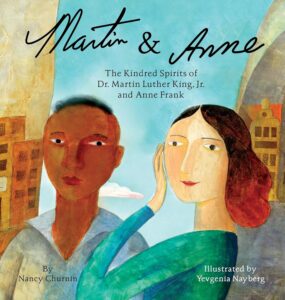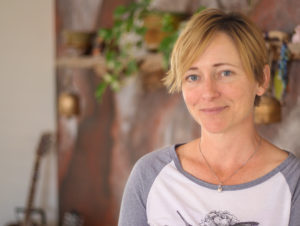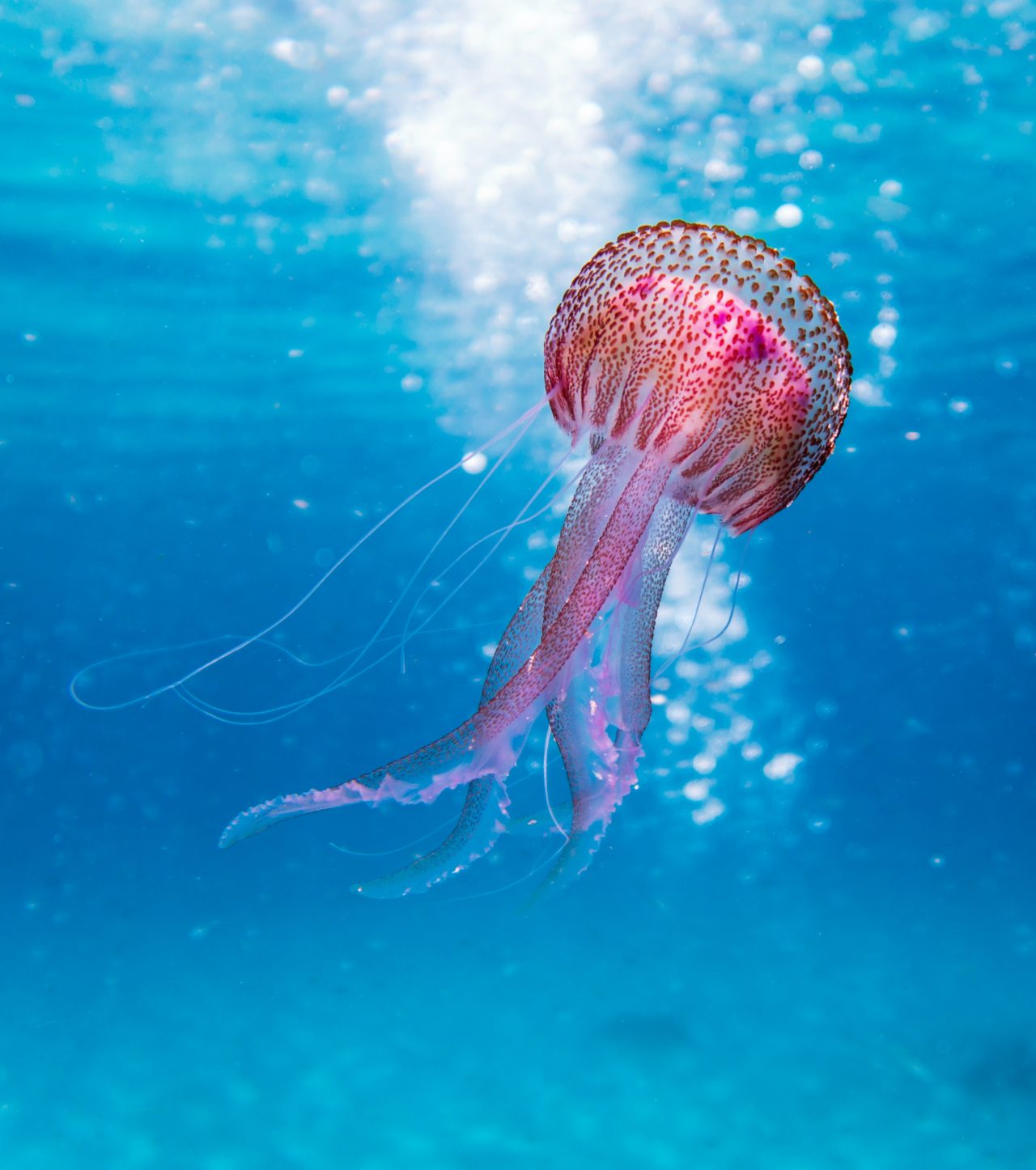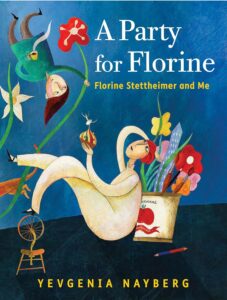A Party for Florine: Florine Stettheimer and Me
Author: Yevgenia Nayberg
Illustrator: Yevgenia Nayberg
Neal Porter Books
16 July 2024
40 pages
Ryan’s Review of the Writing
 I’ve been a fan of Yevgenia Nayberg’s books since the publication of Martin & Me, which eschewed the typical picture book biography format and instead offered parallel stories of Martin Luther King Jr. and Anne Frank. Similarly, her new book, A Party for Florine is an unusual take on the life and work of a famous person–Modernist painter Florine Stettheimer.
I’ve been a fan of Yevgenia Nayberg’s books since the publication of Martin & Me, which eschewed the typical picture book biography format and instead offered parallel stories of Martin Luther King Jr. and Anne Frank. Similarly, her new book, A Party for Florine is an unusual take on the life and work of a famous person–Modernist painter Florine Stettheimer.
The story begins with a girl entering a museum and coming across a painting of a girl that looked a lot like herself. The girl in the painting “was holding a palette and brushes.” The narrator says she’s an artist, too, so she decided: “I must learn all about her!”
Here, we get some of the typical picture book biographical material, such as the artist’s full name, her date of birth, and where she lived. But it’s filtered through the narrator’s mind, which works to contextualize the information through her own life. Perhaps the artist’s Jewish family “was just like my Jewish family” she wonders. It’s an effective technique.
The narrator is charmed to learn about the famous people who visited Florine and attended her parties. And the narrator has an artist’s eye for colors and images throughout all she shares with the reader. Even in her regular life (sitting in her room during a rainstorm or walking outside the next day, etc.), she’s clearly affected by the effect of Florine–she sees more brightly and brilliantly similar to how Florine painted (and lived).
I’m especially taken by how often the narrator reframes things in her own world, such as her striped T‑shirts, comparing Florine’s art teacher to her own, or noting how the Alwyn Court building “looked like a slice of giant cake”. When she imagines a party she’d like to hold for Florine, she does even more of this: “I would decorate the table with giant flowers as big as bicycle wheels.” Lovely. I think young readers will respond quite well to this kind of evocative language here and elsewhere in the text.
The story ends with the narrator seeing the world anew, which demonstrates the positive effect of Florine’s influence on her. Would it be more pronounced if we had a stronger sense of how the narrator saw the world prior to this seminal museum experience? Perhaps.
The book includes a lengthy Author’s Note which explains how the author first learned about the painter. It also offers many of the details I yearned for earlier in the story, such as:
- Was the narrator researching the girl in the painting or the author of the painting? (It was a self portrait, so both)
- How big was Florine’s family? (She was the fourth of five siblings, one of four girls)
- Did Florine’s famous friends become characters in her paintings? (Frequently they did!)
- How famous/successful was Florine in her own time? (It seems as if she enjoyed modest success in her lifetime but after her death, her reputation grew a good deal)
- Did success matter to Florine? (Apparently, she was independently wealthy–though I had to Google for this)
- How did Florine feel about sharing her art? (“Letting people have your paintings is like letting them wear your clothes,” is SUCH a good line that I wanted it in the main text vs the two pages of Author’s Notes)
- Did Florine write poetry as the main character (perhaps) did? (Yes)
The Author’s Note gave me pause by mentioning how Florine studied art in Germany (Stuttgart) with “Fräulein Sophie von Prieser,” but in the main text, it was in Vienna (Austria). I might be missing an implied transition somewhere, though I always worry that young readers will miss as much (or more) than I do, so this is the type of thing I focus on as a picture book creator and editor. (It’s important to note that young readers also see more than some adults via their own creative observations and connections–they’re not less capable, just different!)
There’s a noticeable emotional undercurrent here that I’m unsure what to do with. It starts at first glance of the painting, where the narrator is talking about herself as “someone I knew too well.” And lines later, the girl she’s identifying with in the painting is described as someone with fiery eyes who could “start crying at any moment.” There’s also the self-doubt revealed by her being unable to believe her art teacher who says “Good job.” There’s more here beyond this, but as I said, it’s not a clear throughline that informs the story despite catching my attention.
In sum, this is a story that goes beyond the typical picture book biography in an imaginative, interesting way. In one sense, it’s also the story of how one creative finds inspiration in the life and work of another, but it’s also about helping readers of today learn about neglected figures from the past. Clearly, Florine is someone whose life and work is well worth considering.
4 out of 5 pencils
Bonnie’s Review of the Illustrations
Yevgenia Nayberg’s illustrations perfectly complement her story about New York painter, poet, and salonnière Florine Stettheimer. Colorful figures bend and float expressively in ever-shifting planes of existence as Nayberg evokes the spirit of the celebrated Modernist’s style. It’s no wonder she has created this book, for when you see the first spread, a self-portrait of Florine stares back at you, and it could very well be the face of the author-illustrator as well.
As you move through the story the present is juxtaposed with the past as the young narrator leans into her imagination. Clever details piqued my interest, like the large still life with our narrator miniaturized and perched on a peach. Next to her a bouquet of flowers—mixed with artist tools—is tagged with a mysterious love note from Marcel Duchamp to Florine’s sister.
Visible brush strokes, collage elements, subtle textures, and charming speech bubbles add to the delightful Jazz Age renderings. Spot on portraits of historical figures pepper the scenes and give you a sense of the high society world Florine was a part of.
A particularly beautiful spread near the end of the book resonates like poetry as the text and imagery bring to mind the Greek goddess Persephone. Florine leaves the scene as a trail of flowers bloom behind her. Like demigods, artists find a version of immortality through the sharing of their work past their natural life. I encourage any lover of art, young or old, to add this book to their collection.
5 out of 5 paintbrushes

Bonnie Kelso loves diving into the details of art history, especially when it’s about an artist who rubbed elbows with Gertrude Stein and Georgia O’Keeffe.
Bonnie is the author and illustrator of three picture books with more on the way. Her debut, Nudi Gill: Poison Powerhouse of the Sea, was selected to represent Nevada at the 2023 National Book Festival in Washington, D.C. Her most recent release, Sea Smiles, is the first book in a series that blends childhood milestones with fascinating facts about sea animals.
A graduate of the Rhode Island School of Design, Bonnie’s past experience in art spans a spectrum, from abstract painting on canvas to museum-quality exhibit design. She has worked with clients such as the Smithsonian, National Geographic, and NASA.
She lives in Las Vegas with her partner, two sons, a Boston Terrier, and an unruly cat. To learn more about Bonnie’s work, please visit www.BonnieKelso.com.


